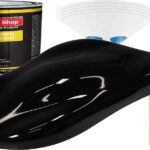Introduction to Automotive Paint Stripper
Automotive paint stripper plays a crucial role in vehicle restoration and refinishing by effectively removing old layers of paint, primer, and clear coat from vehicle surfaces. This chemical solution offers a time-efficient method compared to mechanical alternatives like sanding, making it indispensable in automotive workshops and DIY projects alike. Understanding its types, application techniques, and safety considerations ensures successful paint removal while maintaining surface integrity for subsequent refinishing.
Purpose and Benefits of Automotive Paint Stripper
Automotive paint stripper is a specialized chemical solution designed to efficiently remove layers of old paint, primer, and clear coat from vehicle surfaces. Here’s why it’s essential in vehicle maintenance and restoration:
Purpose:
- Paint Removal: Effectively strips multiple layers of paint, primer, and clear coat from metal, fiberglass, or plastic surfaces.
- Surface Preparation: Prepares the vehicle’s surface for refinishing by providing a clean and smooth base.
- Time Efficiency: Saves time compared to manual methods like sanding or scraping, especially on large or intricate surfaces.
Benefits:
- Versatility: Suitable for various automotive materials, including metal, fiberglass, and plastic.
- Efficiency: Accelerates the paint removal process, reducing labor time and effort.
- Ease of Application: Available in gel or liquid forms for different application needs, ensuring effective coverage and penetration.
- Prepares for Refinishing: Creates a clean surface for new paint application, ensuring adhesion and a professional finish.
Automotive paint stripper is indispensable for professionals and enthusiasts alike, offering a reliable method to rejuvenate vehicle appearances efficiently and effectively.
Application Techniques for Automotive Paint Strippers
Applying automotive paint stripper correctly is crucial for effective paint removal while maintaining surface integrity. Here’s a step-by-step guide on how to apply paint stripper:
1. Preparation
- Safety Gear: Wear chemical-resistant gloves, safety goggles, and a respirator to protect against fumes and skin contact.
- Ventilation: Work in a well-ventilated area or use exhaust fans to minimize exposure to chemical vapors.
2. Application Process
- Brush or Spray Application: Use a brush, roller, or spray gun to apply the stripper evenly over the painted surface.
- Even Coverage: Ensure the stripper covers the entire area evenly, avoiding thick or uneven application.
- Dwell Time: Allow the stripper to sit on the surface for the recommended duration specified by the manufacturer. This allows the chemicals to soften and lift the paint layers.
3. Paint Removal
- Scraping: After the dwell time, use a plastic or metal scraper to gently scrape off the softened paint layers. Start from one edge and work systematically across the surface.
- Repeat if Necessary: For stubborn areas or multiple paint layers, reapply the stripper and repeat the process until all desired layers are removed.
4. Clean-Up
- Residue Removal: Use a paint scraper or wire brush to remove any remaining paint residue. Follow up with a solvent or water wash to clean the surface thoroughly.
- Neutralization: Some strippers may require neutralization with a specific solvent or water rinse. Follow the manufacturer’s instructions for proper neutralization steps.
5. Final Preparation
- Surface Inspection: Inspect the stripped surface for any remaining paint or residue. Touch up any missed areas as needed.
- Surface Rinse: Rinse the surface with water or a solvent to remove any leftover chemicals or debris before proceeding with further refinishing or painting.
Safety Tips for Using Automotive Paint Strippers
Using automotive paint strippers involves handling chemicals that can be hazardous if not used properly. Here are essential safety tips to ensure safe application and minimize risks:
- Personal Protective Equipment (PPE):
- Gloves: Wear chemical-resistant gloves to protect your hands from contact with paint stripper.
- Eye Protection: Use safety goggles or a face shield to shield your eyes from splashes and fumes.
- Respiratory Protection: Wear a respirator or mask approved for organic vapors to prevent inhalation of fumes.
- Ventilation:
- Work in a well-ventilated area, preferably outdoors or in a workspace with exhaust fans. Adequate ventilation helps disperse fumes and reduce inhalation risks.
- Read and Follow Instructions:
- Carefully read and follow the manufacturer’s instructions and safety data sheet (SDS) provided with the paint stripper. Understand proper application methods, dwell times, and safety precautions.
- Avoid Skin Contact:
- Prevent direct skin contact with paint stripper. If skin contact occurs, immediately wash the affected area with soap and water. Seek medical attention if irritation persists.
- Dispose of Waste Properly:
- Dispose of used paint stripper, paint residues, and cleaning materials according to local regulations and environmental guidelines. Avoid pouring chemicals down drains or into the soil.
- Emergency Preparedness:
- Have a first aid kit readily available in case of accidental exposure or injury. Know the location of emergency eyewash stations and showers if working with highly corrosive strippers.
- Protective Clothing:
- Wear long sleeves, long pants, and closed-toe shoes to minimize skin exposure. Avoid wearing clothing that could absorb chemicals.
- Store Safely:
- Store paint strippers and related chemicals in their original containers in a cool, dry place away from heat sources and direct sunlight. Keep out of reach of children and pets.
- Monitor Use Conditions:
- Monitor environmental conditions such as temperature and humidity, as these factors can affect the effectiveness and safety of paint strippers.
- Seek Professional Assistance:
- If unsure about proper use or encountering difficulties, seek advice from professionals or experienced individuals in automotive refinishing.
Following these safety tips ensures that using automotive paint strippers is done with minimal risk to health and the environment, allowing for effective paint removal while maintaining personal safety.
Automotive paint stripper is a valuable tool for restoring vehicles by efficiently removing old paint layers. Understanding its types, application techniques, and safety precautions ensures effective and safe use in vehicle maintenance and restoration projects. Always prioritize safety and environmental responsibility when using chemical-based products in automotive work.

